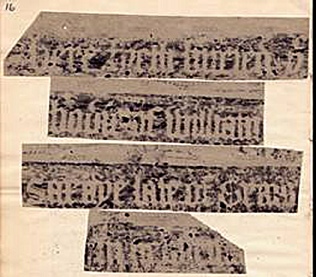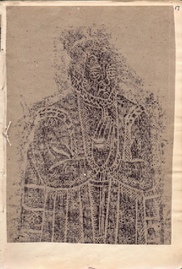THE BAESH MEMORIAL TABLETS
Here lieth buried the body of Edward Baesh Esquire, General Surveyor of the Victuals for ye Navye Royal & ye Marine Affayres within the realms of England and Ireland, In which office he served under fower princes of this island, viz. King Henry the 8 King Edward 6 Queane Mary and Queane Elizabeth, until the time of his death , which was the seconde of May, 1587, in ye 29 years of the reign of Queene Elizabeth, and died aged 80 yeares; he marryed with Jane Sadler one of the davhters of Sir Ralph Sadler, Kt Chancellor of the Dutchie of Lancaster, and had issue by her Ralph and William. Jane Baeshe, deceased ye 7th of April 1614.

THE AUTHORS MUSE TO THE READER
Reader go not yet away
Let my tears entreat thee stay
Heare we speake of him but truth
First Maecenas of my youth;
In few words I will thee tell
That this dead man lived well
For wife wealth and children he
was as blest as man could be.
And tho God did thus enrich him
Yet world’s love did not bewitch him


He kept hospitalitie
No man more of his degree.
Bovld in God (that was his word)
Therefore gave he to the Lord
This isle praying it might keepe
Him and his peace to sleepe
Till Christ’s trvmpet shall awake them
And to blisse eternal take them.
Before his day however , another event which caused widespread comment had brought excitement to us. For long London’s water supply had been inadequate for the growing city and much of it was filthy. Sir Hugh Myddleton proposed to carry pure water from Ware and Amwell’s springs to London but few believed such a plan to be possible. Once more local workers could be called upon to help and they must often have wondered if the task of running the water along the river they were cutting and through the rough elm and oak trunk pipes would ever be completed. The years 1609 to 1613 saw the “mad” Scheme completed and our water added to the air which had pleased Henry VIII as being so very beneficial. The river Lea had also received more attention for in 1571 an Act of Parliament had been passed for its being again made navigable.
In 1636 Edward Baesh mentioned above, now a knight, founded the Baesh charity under which we still enjoy considerable benefits.
His bequests are as follows:-
1. The Almshouses. Which he built and endowed by leaving various pieces of land
in the hands of the trustees the rents from these providing 1/-
2. He gave the Clockhouse (which had been built in the 16th century ) and endowed it as a Free Grammar School for boys, with £20 from the land rents to be paid to the Schoolmaster to teach the sons of poor parishioners and directed that the Lord of the Manor be perpetual patron. This £20 was transferred, in 1879, to the Baesh scholarship trust to pay for two boys to go to Ware grammar school and since the 1944 education act it has been taken over by the Charity Commissioners.
3. He also gave a house for the Sexton or Clerk of the parish (this was demolished about 60 years ago) and built the present Vicarage for which the Vicar was to pay a rent of 12 pence at Christmas time to the poorest person in the parish.
4. He directed in his will that any surplus funds should be used to apprentice a poor boy to a useful trade.
In 1678 the charge of £25 on the manor was varied to be applicable instead to two
specific fields:-
The charity was to be administered by 12 trustees chosen then and recorded in a deed costing £20 to draw up. When the number of trustees was reduced by death to six, a new set were to be chosen and a new deed drawn up.
It was as well that this member of the Baesh family was so generous to the village, for his son Ralph, who succeeded him supported the King in the Civil War and this cost him so dearly that he is forced to sell part of the manor for £300. Though no fighting took place in this area men from our homes are certain to have followed so well known a family as that of Ralph Baesh to war and the vaults of Rye House and Stansteadbury may well have hidden loyalists from Cromwell’s men. It was incidents such as these which gave rise to stories of secret tunnels and these are linked with Rye House, Stansteadbury, the Red Lion and Saint James’s church. The most likely of these to have existed would be one connecting Stansteadbury to the church the two being comparatively close but apart from the distance apart of all the others, the fact that the land between them is so low and liable to floods would seem to rule out any possibility of tunnels.
The last mention of the Baesh family is a sad one, for the third Sir Edward, having sold the manor in 1676 to Edmund Fielde is recorded in 1698 as “having sold all his estate and very poor”.
In 1665, with London ravaged by the great plague our air of which Henry VIII thought so much probably attracted many who fled from the city but there is no record of plague here. The great fire which followed the plague however, had its small counterpart here for in the same year (1666 ) the maltings of John Burnap (he who had earlier been accused of trading without the required apprenticeship) were burnt down and he applied to the courts for permission to appeal to all and sundry for relief.
The customs of those days are also reflected in a record of the session rolls that Mr. Fownes, Mr. Rumball, John Simpson and John Burnap, all of Stanstead, were summoned for not attending their parish church “two Lord’s Days immediately before 14th Sept 1670“. Though churchgoing was compulsory, real love of the church is shown in the improvements made to the church in many ways. The three bells still in the tower of St James’s are inscribed “Robert Oldfield made me 1605 “God save the King 1617” and “ PhilipTrahhearne C. warden , John Briantfecit 1790“. It is said that the tower originally contained eight bells and that the other five were sold to Royston to pay a debt, but the truth of this is not certain. The Bible which is still used was given in 1717 and the communion silver, consisting of Flagon cup and Patens date from 1714. The quaint box pews too date from about 1700 and must then have been as great an attraction to people as they are to small boys today. In one of the pews in the north chapel there is a hole giving a peeping place to see into the next pew. This would be the Lord of the Manor’s pew and it is probable that the hole enabled him to keep an eye on his family in the days when families were large. This north chapel has, since it was built Sir Edward Baesh always been the part used by the family living at Stansteadbury.
Religious difficulties must have affected the occupants often and there were signs in one of the cellars of its use as a chapel. Other explanations of the niches in the cellar walls have been given but the long occupation of the house by monks prior to the dissolution of the monasteries would make it likely that those wishing to practice the rites of Roman Catholicism in secret would turn to the manor house. Parts of the present house may have been built before 1600 but it has been added to so frequently that it is impossible to be certain.
Political quarrels also affected us and the continued struggle between King and Parliament led to the most famous page in our history – the Rye House plot. Though stories told are so contradictory that the full facts are clouded in doubt, the main events seem to have been as follows. After long quarrels among the King’s (Charles II’s) statesmen and after several plans had been discussed and rejected, they chose Rye House as the site for the attempt. One Rumbold, a member of the conspirators, occupied the Rye House as a maltster and he had often noted how easy it would be for anyone to waylay a coach there, it being very lonely and the road passing between the castle wall and a thick hedge. He also, on many occasions, noticed that the Kings’ coach was unguarded. The plan adopted was to stop the coach by placing an overturned waggon in the road whereupon a body of horsemen would leap out, kill the King and make off across country. Fortunately for the king, there was a fire at Newmarket that day and he returned early, so the plan was not carried out. In fact, it was not for some time that the plot was discovered, one of the plotters turning traitor to save his own life. So many intrigues and lies surround the story that it is not even possible to say who was actually in the plot for the king made this an opportunity to punish several of the barons with whom he had quarrelled. Of the six arrested, Monmouth fled, Essex took his own life, Russell and Algernon Sydney were beheaded, Hampden imprisoned and Howard turned traitor to save his skin. Whatever the truth, the King certainly rid himself off a powerful body of man who had opposed his reign and Rye House earned lasting fame.
Before leaving this period of history, another family merits mention for its generosity though in this case the village did not benefit. In St James’s church will be found a Brass and inscription to the memory of William Saxaye, a rubbing of which, together with a note of the almost obliterated writing will be found on the next pages. His mother gave numerous gifts for the benefit of education, founding scholarships and fellowships at Caius and Emmanuel colleges, Cambridge and giving a house and a fellowship at Brasenose college. The generosity was so much appreciated at the latter college that her name was included in the Grace after meals.
A further study of session roles of the 17th century throws indirect light on the occupations. Thus, in 1606, a petition was presented that “the inhabitants of Stansteede are greatly annoyed by the making of wode (charcoal burning ) so that not only they but strangers are constrained to stope their nosses as they go by, the stink is so greate”. In 1663, John Burnap, maltster, was summoned for “using the trade of grocer for 12 months without having served the necessary seven years apprenticeship”. From its frequent mention, it is clear that malting has been one of the earliest and most constant of village occupations.

Rubbing of the first line of the Saxaye memorial wording. Now hardly legible it
reads :-
This is one of several old brasses in St James’ church. A rubbing of the upper half of the Brass itself follows.

 Continued
Continued